|
11 -
ANGELS
AND OTHER EMISSARIES
A nighttime vision, a UFO sighting, and the appearance of angels
come together in one of the most intriguing dream reports in the
Bible, known as Jacob’s Dream. It was a most significant Divine
Encounter, for in it Yahweh himself vowed to protect Jacob, the son
of Isaac and grandson of Abraham, to bless him and his seed, and to
give the Promised Land to him and his descendants forever.
The circumstances leading to this Divine Encounter, in which
Jacob - in a vision - saw the Angels of the Lord in action, were the
journey of Jacob from Canaan, where the family had settled, to
Harran, where other members of the family of Abraham had stayed on
when Abraham continued southward toward the Sinai and Egypt.
Concerned lest his son Jacob, with whom the divinely ordained
succession rested, marry a pagan Canaanite,
"Isaac called Jacob and
blessed him and ordered him thus: Thou shalt not take a wife from
the daughters of Canaan; arise, go to Padan-Aram, to the house of
Bethuel thy mother’s father, and take thyself from there a wife from
among the daughters of Laban, thy mother’s brother."
Harran, it will be recalled, was a way station (which is what its
name meant) on the northern route from Mesopotamia to the
Mediterranean lands and thence to Egypt. It was there that Abraham
stayed with his father Terah before he was ordered to proceed
southward; and it was there that Esar-haddon (some fifteen hundred
years later) received the oracle
to invade Egypt and Nabunaid was chosen to Kingship over Babylon.
(Harran, still called by its ancient name, is still a major city in
southern Turkey; but since Moslem shrines have been built upon the
ancient mound, with the main mosque where the ancient sacred
precinct had been (Fig. 85), archaeologists are prevented from
excavating there. But numerous structural remains are still
associated with Abraham, and a well northwest of the city is called
Jacob’s Well - see ensuing tale).
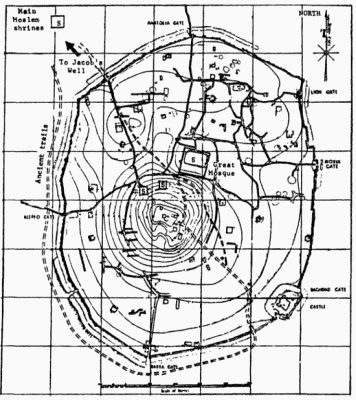
Figure 85
Starting his northward trek from Beersheba, Jacob reached at the end
of one day a place where his grandfather Abraham had once encamped
on the opposite journey, from Harran to
Beersheba. Tired, Jacob lay down to sleep in the rocky field. What
ensued is best told in the Bible’s own words (Genesis chapter 28):
And Jacob went out from Beersheba and went toward Harran. And he
reached a certain place and went to sleep there, for the sun had
set. And he took of the stones of that place and put them to rest
his head on, and he lay down in that place.
And he dreamed, and beheld a ladder set up on the ground with its
top reaching up to the sky. And behold, angels of Elohim were going
up and coming down on it.
And behold, there was Yahweh standing upon it, and he spoke, saying:
"I am Yahweh, the Elohim of Abraham thy ancestor and the Elohim of
Isaac. The land upon which thou liest, to thee I will give it and to
thy seed. And thy seed shall be spread as dust on the ground,
spreading west and east and northward and southward; and in thee and
in thy seed shall all the communities of the Earth be blessed.
Behold, I am with thee; I will protect thee wherever thou goest, and
I shall bring thee back to this land. I shall not abandon thee until
I have done that which I am saying to you."
And Jacob awakened out of his sleep, and said, "Surely Yahweh is
present in this place, and I knew it not."
And he was afraid, saying: "’How awesome is this place! This is none
other than an abode of Elohim, and this is the gateway to heaven!"
And Jacob got up early in the morning and took the stone that he had
used as a pillow, and set it up as a pillar, and poured oil on its
top, and called the name of the place Beth-El.
In this Divine Encounter, in a nighttime vision, Jacob saw what,
without doubt, we would nowadays call a UFO; except that to him it
was not an Unidentified Flying Object: he well realized that its
occupants or operators were divine beings, "angels of Elohim," and
their Lord or commander none other than Yahweh himself, "standing
upon it." What he had witnessed left no doubt in his mind that the place was a "Gateway to
Heaven" - a place from which the Elohim could rise skyward. The
wording is akin to that applied to Babylon (Bab-Ili, "Gateway of the
Elohim") where the incident of the launch tower "whose head shall
reach to heaven" had taken place.
The commander identified himself to Jacob as "Yahweh, the
Elohim" - the DIN.GIR - "of Abraham thy forefather and the Elohim of
Isaac." The operators of the "ladder" are identified as "Angels of
Elohim," not simply as angels; and Jacob, realizing that he had
unknowingly stumbled upon a site used by these divine aeronauts,
named the place Beth-El ("The House of El"), El being the singular
of Elohim.
A few words on etymology and thus on the identity of these "angels"
are required.
The Bible is careful to identify the subordinates of the deity as
"Angels of Elohim" and not simply as "angels," because the Hebrew
term Mal’akhim does not mean "angels" at all; it literally means
"emissaries"; and the term is employed in the Bible for regular,
flesh-and-blood human emissaries who carried royal rather than
divine messages.
King Saul sent Mal’akhim (commonly translated
"messengers") to summon David (I Samuel 16:19); David sent Mal’akhim
(also translated "messengers") to the people of Jabesh Gilead to
inform them that he had been anointed king (II Samuel 2:5); King
Ahaz of Judaea sent Mal’akhim ("emissaries") to the Assyrian king
Tiglat-Pileser for help to ward off enemy attacks (II Kings 16:7),
and so on.
Etymologically, the term stems from the same root as Mela’kha which has been variably translated as "work," "craft,"
"workmanship." The Bible employs the term in this derivation in
connection with the "Wisdom and Understanding" that Yahweh gave
Bezalel to be able to carry out the Melakha required for building
the Tabernacle and the Ark of the Covenant in the Sinai wilderness,
so a Mal’akh (the singular of Mal’akhim) signified not a mere
messenger but a special emissary, trained and qualified for the task
and with some powers of discretion (as an ambassador would have).
It is to "Angels of Elohim," the Divine Emissaries, that the
reference will be in the following pages.
The story of Jacob is dotted with oracle dreams and angelic
encounters - continuing, as we shall see, the experiences of the
Patriarchs, his grandfather Abraham, and his father Isaac.
Meeting Rachel at the water well in the grazing fields of Harran and
discovering that she was the daughter of his uncle Laban, Jacob
asked Laban’s permission to marry her. The uncle agreed if Jacob
would in exchange serve Laban seven years; but when he did, Laban
made him marry first his older daughter Leah, demanding that he
serve another seven years to have Rachel as a second wife. Upon the
insistence of Laban, Jacob, his wives, the children they bore him,
and the flocks that he managed to amass, stayed on and on - for twenty
years. Then one night Jacob had a dream. In the dream he saw "rams
leaping upon the flocks, and they were streaked, and speckled, and
grizzled."
Puzzled by what he was seeing, Jacob then received a
divine oracle in the second part of the dream in which an "Angel of
the Elohim" appeared and called out his name.
"And Jacob said, Here
I am. And the angel said, Lift up thy eyes and see thou all of the
rams that leap upon the flocks; they are streaked and speckled and
grizzled because I have seen all that Laban had done to thee. I am
the El of Beth-El, the place where thou didst anoint a pillar . ..
Now arise, and get thee from out of this land, and return to the
land of thy birth."
So, acting on this dream-oracle, Jacob picked up his family and
belongings, and seizing the opportunity when Laban was away for the
shearing of the sheep, left Harran in a hurry. When the news reached
Laban, he was furious.
"But Elohim came unto Laban the Aramean in a
nighttime dream, saying to him: Take thou heed! Speak neither
threats nor sweet-talk Jacob."
Thus admonished, Laban in the end
consented to Jacob’s departure, and the two set up a stone to serve
as a boundary between them, not to be crossed by either one of them
in anger. In witness of the treaty’s vows the Elohim were invoked as
guarantors.
The placing of such a boundary stone conformed to the customs of the
day. Called Kudurru, they were rounded at the top; the terms of the
boundary agreement were inscribed on them, ending with the oaths and
the invoking of the Gods of each side as guarantors of the treaty
vows; sometimes, the symbols of the celestial counterparts of the
invoked deities
were engraved near or on the rounded stone’s top (Fig. 86).

Figure 86
It is
thus indicative of the Bible’s accuracy in describing the event when
the biblical narrative (Genesis 31:53) states that "the Elohim of
Abraham and the Elohim of Nahor shall judge between us, the Elohim
of their father." While the name of Abraham’s God, Yahweh, is not
mentioned, a distinction is made between Him and the Gods of his
brother Nahor (who had stayed behind in Harran); all of whom,
according to Laban, were Elohim of their father Terah.
The biblical data suggests that the favored route of the Patriarchs
between the Negev (the southern part of Canaan bordering on the
Sinai peninsula), of which Beersheba was (and still is) the
principal city, involved a crossing of the Jordan River; this
indicates that The King’s Highway east of the river was used (rather
than the coastal Way of the Sea - see Map).
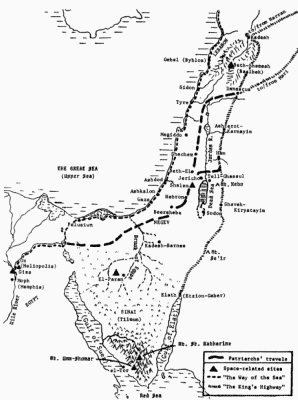
It was when Jacob,
journeying south with his family, retinue, and flocks, reached a
place where the Yabbok tributary created an easier passage to the
Jordan through the
mountains, that his next encounter with Mai‘akhim took place. This
time, however, it was neither in a dream nor in a vision: it was a
face-to-face encounter!
The event is reported in chapter 32 of Genesis:
As Jacob went on his way, Angels of Elohim encountered him. And when
Jacob saw them, he said: "An encampment of Elohim it is!"
And he called the place Mahana’im (the Place of Two Encampments).
The event is recorded here in just two verses, significantly
constituting a separate section in the formal enscribing of the
Bible. In the following verses the subsequent, but unrelated, tale
of Jacob’s meeting with his brother Esau is told. The manner in
which the ancient editors of the Scriptures treated these two verses
brings to mind the manner in which the segment on
the Nefilim has
been told in chapter 6 of Genesis (preceding the tale of Noah and
the ark), where the segment is clearly a retained remnant of a
longer text. So must have been this reference to the encounter with
an actual group or troop of Divine Emissaries - two verses remaining
out of a much longer and detailed record.
The ancient editors of Genesis must have retained the brief mention
because of the subsequent episode, that had to be included because
it explains why Jacob’s name was changed to "Israel."
Reaching the Crossing of Yabbok, and uncertain what his brother
Esau’s attitude would be to see his rival for the succession
return, Jacob adopted a strategy of sending forth his retinue a
little at a time. Finally only he and his two wives and two
handmaidens and his eleven children remained in his encampment for
the night; so, under the cover of darkness, Jacob "took them and
had them cross the stream, bringing over all that had remained."
Then the unexpected Divine Encounter happened:
And Jacob was left alone;
And there wrestled with him a man
until daybreak at dawn.
And seeing that he could not prevail
against him, he struck against the hollow
of his (Jacob’s) thigh; and the hollow of
Jacob’s thigh was put out of joint
as he was wrestling with him.
And he said: "Let go, for it is daybreak. But Jacob said:
"I will
not let thee
leave unless thou bless me."
And he said to him: "What is thy name?"
And he said: "Jacob.
So he said: "Thy name shall no longer be
called Jacob; but rather ‘Israel’,
for thou hast striven with both Elohim
and men, and prevailed."
(Isra-El is a play on the words meaning "strive, contest" with
El, a
deity).
And Jacob asked him, saying:
"Do tell me your name!"
And he said: "Wherefor dost thou ask for
my name?" And he blessed him there.
And Jacob named the place Peni-El
(the Face of El)
For I have seen Elohim face to face
and my life was preserved.
And it was sunrise when he crossed at
Peniel, limping on his thigh.
The first reference in the Bible to an Angel of the Lord, in chapter
16 of Genesis, relates an event in the time of Jacob’s grandfather
Abraham. Abraham and his wife Sarah were getting old - he in his mid
eighties, she ten years younger; and still they had no offspring.
Abraham had just fulfilled the mission for which he had been ordered
to Canaan - to ward off attacks on the Spaceport in the Sinai: the
War of the Kings (described in chapter 14 of Genesis).
The grateful
Lord Yahweh appeared to Abram in a vision, saying: "Fear not Abram; I am thy
shield; thy reward shall be exceedingly great."
But the childless Abraham (still called by his Sumerian name Abram)
responded bitterly: "My Lord Yahweh, what
wouldst thou give me? But I am childless!" Without an heir, Abram
said, what use is any reward?
Then the word of Yahweh came to him, thus:
"None shall inherit thee except he who
shall come out of thy own innards."
And he brought him out, and said:
"lx>ok now up to the heavens, and count the
stars, if thou be able to number them;
that many shall be thy seed."
"It was on that day that
Yahweh had made a Covenant with Abram,
saying: Unto thy seed have I given this land,
from the Brook of
Egypt until the great river,
the River Euphrates."
But, the biblical tale continues, in spite of that promise of
countless descendants, Sarah still did not bear a child to Abraham.
So Sarah said to Abraham that perhaps it was the Lord’s intention
that Abraham’s offspring should not depend on her ability to bear
children, and suggested that he "come unto" Hagar, her Egyptian
handmaiden. And "Hagar became pregnant," and began to belittle her
mistress.
Although it was her own suggestion, Sarah was now furious, "and
dealt harshly with Hagar," and Hagar ran away.
And an angel of Yahweh found her
by a spring in the desert, the spring
which is on the Way of Shur.
And he said to Hagar, Sarah’s handmaiden,
"Whence comest thou and whither goest thou?"
Explaining that she was running away from her mistress Sarah, the
angel told her to go back, for she would have a son and by him
numerous offspring. "And thou shalt call his name Ishma-El" - ‘God Has
Heard’ - for Yahweh hath heard thy plight." So Hagar went back and
gave birth to Ishmael; "and Abram was eighty-six years old when
Hagar bore Ishmael to Abram." It was not before another thirteen
years had passed that Yahweh once again "appeared unto Abram" and,
reaffirming the Covenant with Abraham and his offspring,
took steps to provide Abraham with legitimate succession through a
son by his half sister (Sarah).
As part of the legitimization,
Abraham and all his male household had to be circumcised; and as
part of inheriting Canaan and severing the remaining ties to the Old
Country, Sumer, the Hebrew Patriarch and his wife had to shed their
Sumerian names (Abeam and Sarai) and adopt Semitic versions thereof,
Abraham and Sarah. (Our references to "Abraham" and "Sarah" prior
to this occurrence were for convenience only; in the Bible, up to
that point, they were called Abram and Sarai). And Abraham was
ninety-nine years old at the time.
The details of these divine instructions, coupled with the
foretelling of the birth of Isaac by Sarah, are given in chapter 17
of Genesis. The circumstances - the Theophany leading to the
upheavaling of Sodom and Gomorrah - are described in the following
chapter, "when Yahweh showed himself" to Abraham. The aging
Patriarch was sitting at the entrance to his tent; it was midday,
the hottest time of the day. Suddenly, three strangers appeared to
Abraham as if from nowhere:
And he lifted up his eyes and lo, he beheld three persons standing
above him. And when he saw them, he ran toward them from the
entrance of the tent, and bowed down. And he said:
"My lord, if I find favor in thy eyes, please do not pass over
above thy servant.
The scene is replete with mystery. Three strangers appear to Abraham
suddenly, seen by him as he lifts his eyes skyward. He sees them
standing "above him." Though unidentified at this point, he quickly
recognizes their extraordinary - divine? - nature. Somehow one of them
is distinguished, and Abraham addresses him, calling him "My Lord."
His words begin with the most important request: "Please do not pass
over above thy servant." He recognized, in other words, their
ability to roam the skies . . . Yet they were so humanlike that he
offers them water, to wash their feet, to rest in the tree’s shade,
and to sustain their hearts with food, before they "pass over"
onward. "And they said, Do as thou hast spoken."
"So Abraham hastened into the tent unto Sarah," and asked her to
quickly prepare bread rolls while he oversaw the preparation of a
meat dish, and had the meal served to them. And one of them,
inquiring about Sarah, said: "In a year’s time, when I return to
thee, Sarah thy wife shall have a son." Overhearing that in the
tent, Sarah laughed, for how could she and Abraham, too old by now,
have a son?
Then Yahweh said unto Abraham: "Wherefore did Sarah laugh, thinking:
Would I really bear a child when I have waxed old? Is anything too
wondrous for Yahweh? At the appointed time I will return unto thee,
at the same time next year, and Sarah will then have a son.
And it would be through Isaac and his seed that the Covenant with
Abraham shall be everlasting, Yahweh said.
As the tale continues, we read that "the persons rose up from there
to survey over upon Sodom; and Abraham went with them to see them
off." But while the narrative continues to describe the three sudden
visitors as Anashim - "persons" - the oracle regarding the coming birth
of Isaac (whose Hebrew name, Itz’hak, was a play on words on the
"laughing" by Sarah) has let us know that one of the three was none
other than Yahweh himself. It was a most remarkable Theophany in
which the Hebrew Patriarch was privileged to have the Lord Yahweh as
his guest!
Arriving at a promontory from which Sodom could be seen down in the
valley of the Sea of Salt, Yahweh decided to tell Abraham what was
the reason for the visit.
Because the outcry regarding Sodom and
Gomorrah has been great, and the accusations
against them being grievous, [I said:]
Let me come down and verify:
If it is as the outcry reaching me,
they will destroy completely;
and if not, I wish to know.
This then was the mission of the other two "persons" who were with
Yahweh - to verify the truth about, or extent of, the "sinning" of the
two cities in the Jordan valley near what is now the Dead Sea, so
that the Lord could determine their fate. "And the persons turned
from there and went to Sodom, but Abraham remained standing before
Yahweh," we read in Genesis 18:22; but when the arrival of the two
"persons" at Sodom is reported next (Genesis 19:1), it becomes
clear who the two were: "And the two angels came to Sodom in the
evening." The three visitors who had appeared to Abraham were,
thus, Yahweh and two of his emissaries.
Before the Bible focuses on the angels’ visit to Sodom and Gomorrah
and the ensuing destruction of the "evil cities," the Bible reports
a most unusual discourse between Abraham and Yahweh. Approaching the
Lord, Abraham took on the role of an intercessor, a defense lawyer,
for Sodom (where his nephew Lot and his family have been residing).
"Perhaps there be fifty Righteous Ones inside the city," he said to
Yahweh, "wilt thou destroy and not spare the place for the sake of
the fifty? Surely, far be it from thee, to slay the Righteous with
the wicked?"
Reminding Yahweh that he was "Judge of all the Earth," one who would
always do justice, Abraham placed the Lord in a dilemma. So the Lord
Yahweh answered that if there be fifty Righteous Ones in Sodom, he
would spare the whole city. But no sooner had the Lord consented
thus, than Abraham - asking forgiveness for his audacity in "taking
leave to speak to my Lord" - posed another question: What if the
number, fifty, shall fall short by five? "And He said, I will not
destroy if I find there forty-five."
Seizing the offensive, Abraham
then bargained on, reducing the number of Righteous Ones on account
of whom the whole city would be spared all the way down to ten. And
with that, "Elohim went up from over Abraham," rising skyward from
whence He had appeared earlier in the day. "And Abraham returned to
hrs place."
"And the two angels came to Sodom in the evening, and Lot was
sitting at the gate of Sodom. And Lot, seeing them, rose up toward
them and bowed himself with the face to the
ground. And he said, If it please my lords, do turn unto thy
servant’s house for the night, and wash your feet; and in the
morning, arising early, continue on your way."
As the two stayed in
Lot’s house,
"the people of the city, the people of Sodom, young and
old, closed in on the house; and they called out unto Lot: ‘Where
are the men who had come to thee tonight? Bring them out to us so
that we may know them.’ "
And when the people persisted, even
attempting to break down the door to Lot’s house, the angels "smote
the people at the door, young and old, with a blindness, and they
gave up finding the door."
Did the angels use some magical wand, a beam emitter, with whose
powerful ray the people who were trying to break down the door were
smitten with blindness? In the answer to this question lies the
answer to a greater puzzle. In describing the arrival of the
visitors to Abraham and then to Lot, the visitors are called
Anashim - "people" (not necessarily "men" as the term is often
translated). Yet in both instances the hosts at once recognize
something that made them look different, something "divine" about
them. The hosts call them right away "lords," bow to them. If, as it
is described, the visitors were fully anthropomorphic, what was
nevertheless so different and distinguishing about them?
The answer that comes instantly to mind will no doubt be, Why - of
course - their wings! But that, as we shall show, is not necessarily
so.
The popular notion of angels, an image sustained and bolstered by
centuries of religious art, is that of fully anthropomorphic,
humanlike beings who, unlike people, are equipped with wings.
Indeed, were they to be stripped of their wings, they would be
indistinguishable from humans. Brought over to Western iconography
by early Christianity, the undoubted origin of such a representation
of angels was the ancient Near East.

Figure 87
We found them in Sumerian
art - the winged emissary who led Enkidu away, the guardians with the
deadly beams. We find them in the religious art of Assyria and
Egypt, Canaan and Phoenicia (Fig. 87). Similar Hittite
representations (Fig. 88a) were even duplicated in South America, on
the
Gate of the Sun in Tiahuanacu (Fig. 88b) - evidence of Hittite
contacts with that distant place.

Figures 88a and 88b
Though modern scholars, perhaps wishing to avoid religious
connotations, refer to the depicted beings as "protective geniuses,"
the ancient peoples considered them to be a class of lesser Gods, a
kind of rank-and-file divine being that only carries out the orders
of the "Great Lords" who were "Gods of Heaven and Earth."
Their representation as winged beings was clearly intended to
indicate their ability to fly in Earth’s skies; and in that they
emulated the Gods themselves, and specifically so those who had been
depicted as winged deities - Utu/Shamash (Fig. 89) and his twin sister
Inanna/lshtar (Fig. 90).
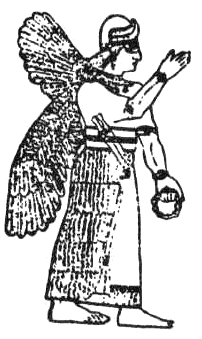
Figure 89

Figure 90
The affinity to the Eaglemen (see Fig. 16)
whose commander Utu/Shamash was, is also obvious. In this regard
the Lord’s statement (Exodus 19:4) that he would carry the Children
of Israel "on
the wings of eagles" might have been more than allegorical; it also
brings to mind the tale of Etana (see Fig. 30) whom an eagle or Eagleman had carried aloft on the orders of Shamash.
But, as the biblical textual descriptions and a glance at
Fig.71 will attest, such winged divine assistants were called in the
Bible Cherubim rather than Mal’akhim. Cherub (the singular of
Cherubim) derives from the Akkadian Karabu - to "bless, consecrate." A
Karibu (male) was "a blessed/consecrated one" and a female Kurihi
meant a Protective Goddess.
As such the biblical Cherubim were
assigned (Genesis 3:24) to guard "the way to the Tree of Life" lest
the expelled Adam and Eve return to the Garden of Eden; to protect
with their wings the Ark of the Covenant; and to serve as bearers of
the Lord, be it as supporters of the Divine Throne in the Ezekiel
vision or by simply carrying Yahweh aloft: "He rode upon a Cherub
and flew away," we read in II Samuel 22:11 and Psalms 18:11 (another
parallel to the tale of Etana). According to the Bible, then, the
winged Cherubim had specific and limited functions; not so the Mal’akhim, the Emissaries who had come and gone on assigned missions
and, as plenipotentiary ambassadors, had considerable discretionary
powers.
This is made clear from the events at Sodom. Having seen for
themselves the viciousness of the people of Sodom, the two Mal’akhim
instructed Lot and his family to leave at once,
"for Yahweh will destroy this city." But Lot tarried, and kept
asking the "angels" to delay the upheavaling of the city until he,
his wife, and two daughters could reach the safety of the mountains
that were not so near. And the emissaries granted him the request,
promising that they will postpone the city’s upheavaling to give him
and his family time to escape.
In both instances (the sudden appearance to Abraham, the arrival at
Sodom’s gate) the "angels" are called "people," manlike in
appearance; if not winged, what then made them recognizable as
Divine Emissaries?
We find a clue in the representation of the Hittite pantheon, carved
in a rock sanctuary at a site called Yazilikaya in Turkey, not far
from the imposing ruins of the Hittite capital. The deities are
arranged in two processions, male ones marching in from the left and
female ones marching from the right.
Each procession is led by the
great Gods (Teshub leading the males, Hebat leading the females),
followed by their offspring, aides, and companies of lesser Gods. In
the male procession the last to march are twelve "emissaries" whose
divinity or role and status are recognized by their headgear and the
curved weapon they are holding (Fig. 91a); ahead of them marches a
somewhat more important group of twelve, again identified by the
headgear and the instrument - a rod with a loop or disc on top - they
are holding (Fig. 91b). This wand is also held by the two principal
male deities (Fig. 91c).

Figures 91a, 91b, and 91c
The twelve-man companies of these lesser Gods in the Hittite
depiction bring unavoidably to mind the troop of Mal’ak-him that
Jacob encountered on his way back from Harran - in today’s Turkey - to
Canaan. What comes to mind, then, is that the possession of a
handheld device was what made the angels recognizable for what they
were (along with, at least sometimes, their unique headgear).
Miraculous deeds performed by Mal’akhim abound in the Bible, the
blinding of the unruly crowd at Sodom being just one of them; a
similar incident of magical blinding is reported in connection with
the activities and prophecies of Elisha, the disciple and successor
of the Prophet Elijah. In another instance Elijah himself, escaping
for his life after having hundreds of the priests of Ba’al killed,
was saved by an "Angel
of Yahweh" as he became exhausted without food and water in the
Negev desert - in the very same area where the Angel saved the
wandering, thirsty, and hungry Hagar.
As the weary Elijah lay to
sleep under a tree, a Mal’akh all of sudden touched him, saying:
"Get up and eat." To his utter surprise, Elijah saw placed at his
head a roll of baked bread and a water jug. He ate and drank a
little and fell asleep - only to be touched again by the Angel,
telling him to consume all the food and the water because there is a
long way ahead (the destination was "the Mount of the Elohim" Mount
Sinai, in the Wilderness). Though the narrative (I Kings 19:5-7)
does not state how the Angel touched Elijah, one can safely assume
that it was not with his hand but with the divine wand or staff.
The use of such an implement is clearly reported in the
tale of Gideon (Judges chapter 6). To convince Gideon that his
selection to lead the Israelites against their enemies was ordained
by Yahweh, the "Angel of Yahweh" instructed Gideon to take the meat
and bread that he had prepared as an offering to the Lord, and place
them on a rock; and when Gideon had done so,
The angel of Yahweh put forth the end of the wand that was in his
hand, and touched the meat and the breadrolls. And there flamed up a
fire out of the rock and consumed the meat and the breadrolls.
Then the angel of Yahweh disappeared from sight; and Gideon realized
that he was [indeed] an angel of Yahweh.
In such instances the magical wand might have looked like the rod
held by the more important group of twelve in the Yazilikaya
procession. The curved instrument held by the last-to-march group
could very well have been the "sword" that was seen held by the Mai
‘akhim when they were sent on destructive missions. One such
sighting is reported in Joshua chapter 5.
As the Israelite leader of
the conquest of Canaan faced his most challenging target - the
exceedingly fortified city of Jericho - a Divine Emissary appeared to
him to give him instructions:
As Joshua was by Jericho,
he lifted up his eyes and lo,
he beheld a man standing opposite him,
a drawn sword in his hand.
And Joshua went toward him, and said to him:
"Art thou one of us or one of our adversaries?" And he answered:
"Neither; the captain of the host of Yahweh I am."
Another occurrence in which a warlike Mal’akh appeared
with a swordlike object in his hand took place in the time of King
David. Not heeding the prohibition against taking a census of his
able-bodied men, he received word from the Lord through Gad the
Visionary that it was up to David which of three punishments would
be meted out by the Lord.
When David hesitated,
He raised his eyes,
and saw the Angel of Yahweh
hovering between the Earth and the heavens,
and his drawn sword stretched out
over Jerusalem.
And David and the Elders, clothed in sackcloths,
fell face down.
(/ Chronicles 21:16)
Equally illustrative are the instances when the Angels appeared
without such a distinctive object in their hands, for then they had
to resort to other magical acts to convince the recipients of the
Divine Word that the embassy was authentic. Whereas in the case of
the encounter by Gideon the magical wand was specifically mentioned,
such a wand was apparently not within sight when the Angel of Yahweh
appeared to the barren wife of Mano’ah and foretold the birth of
Samson, providing he would be a Nazirite and the woman, like her son
once born, abstain from drinking wine or beer or the eating of
unclean foods (additionally, the boy’s hair was never to be cut).
When the Angel appeared a second time to make sure the instructions
for conceiving and for raising the boy were being followed, Mano’ah
sought to verify the speaker’s identity, for he looked like "a man."
So he asked the emissary, "What is thy name?"
Instead of revealing his identity, the "angel did a wonder":
And the angel of Yahweh said to him:
"Why askest thou for my name,
which is a secret?"
So Manoah took the kid of sacrifice and placed it on the rock
as an offering to Yahweh.
And the angel did a wonder,
as Manoah and his wife looked on:
As the flame rose up from the altar,
the angel of Yahweh ascended skyward
within the flame.
And Manoah and his wife were witnessing this;
and they fell on their faces to the ground.
After that the angel of Yahweh did not appear anymore to Manoah and
his wife. But Manoah then knew that an angel of Yahweh it was.
A more renowned instance of using fire magically in order to
convince the observer that he is indeed being given a divine message
is the incident of the Burning Bush. It was when Yahweh had chosen
Moses, a Hebrew raised as an Egyptian prince, to lead the Israelites
out of bondage in Egypt.
Having escaped the wrath of the Pharaoh to
the Wilderness of Sinai, Moses was shepherding the flock of his
father-in-law, the priest of Midian, "and he came to the mountain of
the Elohim in Horeb," where a miraculous sight drew his attention:
And an angel of Yahweh appeared unto him
in a flame of fire, out of the midst of
a thorn-bush.
And he looked and, behold -
the thorn-bush was burning with fire,
but the thorn-bush was not consumed.
And Moses said [to himself ]: "Let me get closer and observe this
great sight, for why is the thorn-bush not burning down?"
And when Yahweh saw that Moses had turned to take a closer look,
Elohim called out to him from the thorn-bush saying: "Moses, Moses!"
And he said: "Here I am. "
Such miracles were not needed for identifying the speaker as a
divine being, as we have recounted, when the speaker was holding the
bent weapon or magical wand.
Ancient depictions suggest that there was probably, at least in some
instances, another distinctive feature by which the "persons" or
"men" were recognized as Divine Emissaries: the special "goggles"
that they wore, usually as part of their headgear. In this regard
the Hittite pictograph that expressed the term "divine" (Fig. 92a)
is instructive, for it represents the "Eye" symbols that
proliferated in the upper Euphrates region as idols (Fig. 92b)
placed atop altars or pedestals. The latter were clearly emulating
depictions of deities whose outstanding feature (beside their divine
helmet) were the goggled eyes (Fig. 92c).
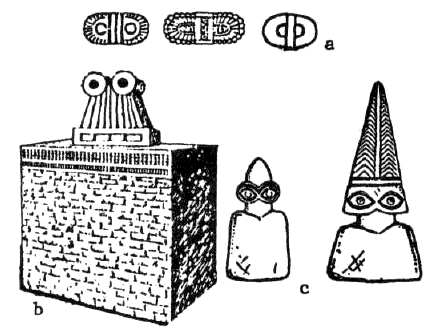
Figures 92a, 92b, and 92c
In one instance the statuette, depicting a helmeted and goggled
Godlike "man" holding a bent instrument (Fig. 93), may well have
represented the way in which the biblical angels had appeared to
Abraham and to Lot.
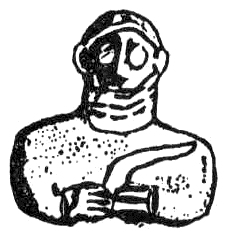
Figure 93
(If, in those instances, the wand-weapon was used to blind with its
beam, the goggles might have been required to protect the "angel"
from the blinding effects - a possibility suggested by recent
developments (by the United States and several other countries) of
blinding weapons as one kind of "nonlethal" weapons.
Called Cobra
Laser Rifles, these weapons employ a technique derived from both
(he surgical laser and the lasers that guide missiles. The soldiers
using them must wear protective goggles, lest they be blinded by
their own weapons).
As a comparison of the above depictions with the helmeted and
goggled Ishtar as a pilot (Fig. 33) suggests, the attire and
weaponry of the Mai ‘akhim only emulated those of the Great Gods
themselves. The great Enlil could "raise the beams that search the
heart of all the lands" from his ziggurat in Nippur, and had there
"eyes that could scan all the lands," as well as a "net" that could
ensnare unauthorized encroachers.
Ninurta was armed with "the
weapon which tears apart and robs the senses" and with a Brilliance
that could pulverize mountains, as well as with a unique IB - a
"weapon with fifty killing heads." Teshub/Adad was armed with a
"thunder-stormer which scatters the rocks" and with the "lightning
which flashes frightfully."
Mesopotamian kings asserted from time to time that their patron
deity provided them with divine weapons to assure a victory; it was
thus even more plausible that the Gods would provide weapons or
magical wands to their own emissaries, the Angels.
Indeed, the very notion of Divine Emissaries can be traced
back to the Gods of Sumer, the Anunnaki, when they employed
emissaries in their dealings with one another rather than with
Earthlings.
The one whom scholars refer to as "the vizier of the great Gods" was
Papsukkal; his epithet-name meant "Father/Ancestor of the
Emissaries." He carried out missions on behalf of Anu, conveying
Ami’s decisions or advice to the Anunnaki leaders on Earth; as often
as not, he displayed considerable diplomatic skills. The texts
suggest that at times, perhaps when Anu was away from Earth,
Papsukkal served as an emissary of Ninurta (although, during the
battle with Zu, Ninurta employed his main weapon-bearer Sharur as a
Divine Emissary).
Enlil’s principal Sukkal or emissary was called Nusku; he is
mentioned in a variety of roles in most of the "myths" concerning
Enlil. When the Anunnaki toiling in the mines of the Abzu
(southeastern Africa) mutinied and surrounded the house where Enlil
stayed, it was Nusku who blocked their way with his weapons; it was
also he who acted as a go-between to diffuse the confrontation.
In
Sumerian times he was the emissary who brought the "word of Ekur"
(Enlil’s ziggurat in Nippur) to those - both Gods and people - whose
fate Enlil had decreed. A Hymn to Enlil, the All-Beneficent stated
that "only to his exalted vizier, the chamberlain (Sukkal) Nusku,
does he (Enlil) the command, the word that is in his heart, make
known." We have mentioned earlier an instance in which Nusku,
standing in the Harran temple with Sin, informed the Assyrian king
Esarhaddon of the divine permission to invade Egypt.
Ashurbanipal, in his annals, asserted that it was "Nusku, the
faithful emissary," who conveyed the divine decision to make him
king of Assyria; then, on the Gods’ command, Nusku accompanied
Ashurbanipal on a military campaign to assure victory. Nusku,
Ashurbanipal wrote, "took the lead of my army and threw down my foes
with the divine weapon."
The assertion brings to mind the reverse
incident reported in the Bible, when the Angel of Yahweh smote the
army of Assyria besieging Jerusalem:
And it came to pass that night that the Angel of Yahwehwent out and smote the camp of the Assyrians, an hundred and
fourscore and five thousand. And when they (the people of Jerusalem)
arose early in the morning, lo and behold: they (the Assyrians) were
all dead corpses.
(II Kings 19:35)
Enki’s chief emissary, named Isimud in the Sumerian texts and Usmu
in the Akkadian versions, inevitably played a role in the sexual
shenanigans of his master. In the "myth" of Enki and Ninharsag, in
which Enki’s efforts to obtain a male successor by his half sister
were related, Isimud/Usmu first acted as a confidant and later as
the provider of a variety of fruits with which Enki attempted to
cure himself of the paralysis with which Ninharsag had afflicted
him.
When Inanna/ Ishtar came to Eridu to obtain the ME’s, it was
Isimud/Usmu who made the arrangements for the visit. Later on, when
the sobered-up Enki realized that he was tricked out of important
ME’s, it was his faithful Sukkal who was ordered to pursue Inanna
(who had fled in her "Boat of Heaven") to retrieve the ME’s.
Isimud/Usmu was sometimes referred to in the texts as "two faced."
This curious description, it turns out, was a factual one; for in
both statues and on cylinder seals he was indeed shown with two
faces (Fig. 94). Was he deformed at birth, a genetic aberration, or
was there some profound reason for depicting him so? While no one
seems to know, it occurs to us that this two-facedness might have
reflected this emissary’s celestial association (see box at the end
of this chapter).

Figure 94
There was something unusual also about the Sukkal of Inanna /Ishtar,
whose name was Ninshubur. The enigma was that Ninshubur sometimes
appeared to be masculine, at which times the scholars translate his
title as "chamberlain, vizier"; and at other times Ninshubur appears
to be feminine, at which times she is called "chambermaid." The
question is, was Ninshubur bisexual or asexual? An androgynous, a
eunuch, or what?
Ninshubur acts as the confidante of Inanna/Ishtar during her
courtship with Dumuzi, in which role she is treated (or assumed to
be) female; Thorkild Jacobsen, in The Treasures
of Darkness, translates her title as "Handmaiden." But in the tale
of Inanna/Ishtar’s escape with the ME’s that she had tricked out of
Enki, Ninshubur is a match for the male Isimud/Usmu and is called
by the Goddess "my warrior who fights by my side" - patently a male
role.
The diplomatic talents of this emissary
were employed to the full when Inanna/Ishtar decided to visit her sister Ereshkigal in
the Lower World, in defiance of a prohibition; in this instance the
great Sumerologist Samuel N. Kramer (Inanna’s Descent to the Nether
World) referred to Ninshubur as a "he"; so did A. Leo Oppenheim
(Mesopotamian Mythology).
The enigmatic bisexuality or asexuality of Ninshubur is reflected
by her/his contesting with other beings - mostly but not only the
creations of Enki - that seem to be neither male nor female as well as
neither divine nor human, a kind of android - automatons in human
form.
The existence of such enigmatic emissaries, and their baffling
characteristics, come to light in the above-mentioned text that
deals with lnanna’s unauthorized visit to the domain of her older
sister Ereshkigal in the Lower World (southern
Africa). For the trip Inanna put on her attire of an aeronaut; the
seven items listed in the texts match her depiction on a life-size
statue that was unearthed in Mari (Fig. 95a, b).
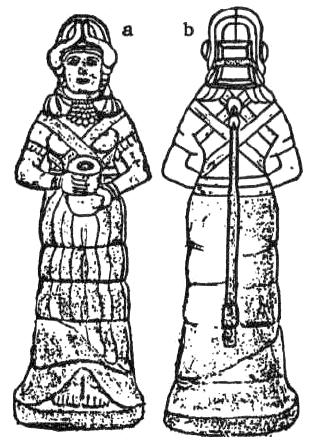
Figures 95a and 95b
As an admission fee
to the restricted zone Inanna had to give up her possessions, one at
a time, as she passed through the domain’s seven gates; then, "naked
and bowed low, Inanna entered the throne room." No sooner had the
two sisters set eyes on each other than both flew into a rage; and
Ereshkigal ordered her Sukkal Namtar to seize Inanna and afflict her
from head to toe. "Inanna was turned into a corpse, hung from a
stake."
Foreseeing trouble, Inanna had instructed her emissary Nin-shubur,
before she had left on the risky journey, to raise an outcry for her
if she does not return within three days. Realizing that Inanna was
in trouble, Ninshubur rushed from God to God to seek help; but none
except Enki could counteract the death-dealing Namtar.
His name
meant "Terminator;" the Assyrians and Babylonians nicknamed him Memittu - "The Killer," an Angel of Death. Unlike the deities or
humans, "he has no hands, he has no feet; he drinks no water,
eats no food." So, to save Inanna, Enki contrived to fashion similar
androids who could go to the "Land of No Return" and perform their
mission safely.
In the Sumerian version of the "myth" we read that Enki fashioned
two clay androids, and activated them by giving one the Food of Life
and the other the Water of Life. The text calls one Kurgarru and the
other Kalaturru, terms that scholars leave untranslated because of
their complexity; referring to the beings’ "private parts," the
terms suggest peculiar sexual organs: literally translated, one
whose "opening" is "locked," and the other whose "penetrator" is
"sick."
Seeing them appear in her throne room, Ereshkigal wondered who they
were: "Are you Gods? Are you mortals?" she asked. "What is it that
you wish?" They asked for the lifeless body of Inanna, and getting
it, "upon the corpse they directed the Pulser and the Emitter,";
then sprinkled her body with the Water of Life and gave her the
Plant of Life, "and Inanna arose."
Commenting on the description of the two emissaries,
A. Leo Oppenheim (Mesopotamian Mythology) saw the main attributes that
qualified them to penetrate the domain of Ereshkigal and save Inanna
as having been
(a) that they were neither male nor female, and
(b)
that they were not created in a womb.
Moreover, he found a reference
to the ability of the Gods to create "robots" in
the Enuma elish,
the Babylonian version of the Creation Epic, in which the celestial
battle with Tiamat and the wondrous creations that ensued were all
attributed to Marduk - including the idea of creating Man.
In this reading of the Babylonian text, it was Marduk, "while
listening to the words of the Gods, conceived the idea of creating a
clever device to help them." Revealing his idea to his father
Ea/Enki, Marduk said: "I shall bring into existence a robot; his
name shall be ‘Man’ ... He shall be charged with the service of the
Gods and thus they will be relieved." But "Ea answered him by making
him another proposition, in order to change his mind regarding the
[idea] of relieving the Gods;" it was, as we have earlier related,
to "put the mark" of the Gods - their genetic imprint - on "a being that
already exists" (and thus bringing about Homo sapiens).
In an updated translation of the Sumerian version Diane Wolkstein
(Inanna, Queen of Heaven and Earth) explains the nature of the two
emissaries as "creatures neither male nor female." A more precise
explanation is provided, however, by the Akkadian version, in which
Enki/Ea created only one being to save Ishtar. As rendered by E.A.
Speiser (Descent of Ishtar to the Nether World) the relevant verses
read:
Ea in his wise heart conceived an image and created Ashushunamir, a
eunuch.
The Akkadian term that is loosely translated "eunuch" is
assinnu,
literally meaning "penis-vagina" - a bisexual being rather than a
castrated male (which is what "eunuch" means). That this was the
true nature of the creature or creatures that baffled Ereshkigal is
evident from actual depictions of them in the form of statuettes
that have been discovered by archaeologists (Fig. 96a); they appear
to possess both male and female organs and thus, by implication, are
of no real sex.
Holding a wand or a weapon, these androids belonged to a class of
emissaries called Gallu - usually translated "demons" - whom we have
already encountered in the story of the death of Dumuzi, when Marduk
had sent the "sheriffs" - the Gallu - to seize him. In a tale dealing with how a son of
Enki, Nergal, had come to espouse Ereshkigal, it is related that to
safeguard his son on his visit to the dangerous domain, Enki created
fourteen Gallu to accompany and protect Nergal. In the tale of
Inanna/Ishtar’s descent to that domain, it is told that Namtar
tried to prevent the escape of the revived Goddess by sending Gallu
to block her ascent.
All these texts point out that although the Gallu had neither the
face nor the body of the divine Sukkals that served as emissaries
between the Gods themselves, they did "hold a staff in their hands,
carried a weapon on their loins." Not flesh and blood, they were
described as beings "who have no mother, who have no father, neither
sister or brother, nor wife or child; they know not food, know not
water. They flutter in the skies over Earth like wardens."
Have these Androids of ancient lore come back in recent times?
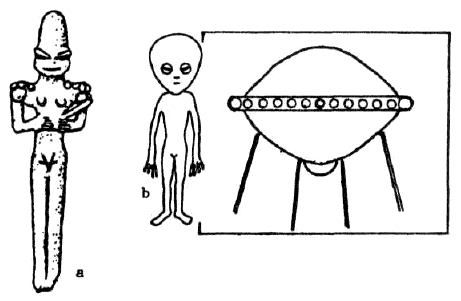
Figures 96a and 96b
The question is pertinent because of the way in which
the occupants
of UFOs have been described by people who claim to have encountered
them (or even abducted by them):
That their depictions (Fig. 96b)
by those who claim to have seen them seem so similar to the ancient
depictions of the Gallu is probably no accident.
There was yet another class of Divine Emissaries - demonic beings.
Some were in the service of Enki, some in the service of Enlil. Some
were considered the descendants of the evildoer Zu, "evil spirits"
that bode no good, bearers of disease and pestilences; demons who as
often as not had birdlike features.
In the "myth" of Inanna and Enki it is told that when Enki ordered
Isimud to retrieve the ME’s taken by Inanna, he sent along with him
a succession of freakish emissaries capable of seizing the Boat of
Heaven: Uru giants, Lahama monsters, "sound-piercing Kugalgal, and
the Enunun "sky giants." They were all, apparently, the class of
creatures called Enkum - "part human, part animal" according to an
interpretation by Margaret Whitney Green (Eridu in Sumerian
Literature) - looking, perhaps, like the fearsome "griffins" (Fig. 97)
that were created to guard temple treasures.
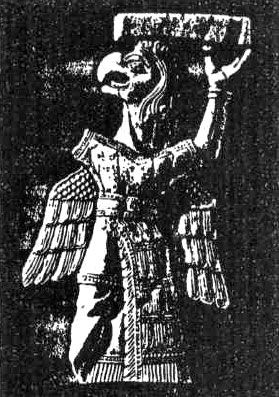
Figure 97
An encounter with a whole troop of such beings is reported in a text
known as
The Legend of Naram-Sin; he was the grandson of Sargon I
(the founder of the Akkadian dynasty) and engaged in several
military campaigns - on orders of the Enlilite Gods, according to his
annals. But at least in one instance, when the divine oracles
discouraged further warfare, he took matters into his own hands.
It
was then that a host of "spirits" were sent against him, apparently
upon a decision or order of Shamash. They were,
Warriors with bodies of cave birds,
a race with raven’s faces.
The great Gods created them;
in the plain the Gods built them a city.
Bewildered by their appearance and nature,
Naram-Sin instructed one
of his officers to sneak up on these beings and prick one of them
with his lance.
"If blood comes out, they are men like us," the king
said; "If blood does not come
out, they are demons, devils created by Enlil."
(The officer’s
report was that he did see blood, whereupon Naram-Sin ordered an
attack; none of his soldiers returned alive.)
Of particular prominence among the part-anthropomorphic,
part-birdlike demons was the female Lilith (Fig. 98). Her name meant
both "She of the night" and "The Howler," and she specialized,
according to beliefs (or, as some prefer, superstitions) that
endured for millennia, in enticing men to their deaths and snatching
newborn babies from their mothers.
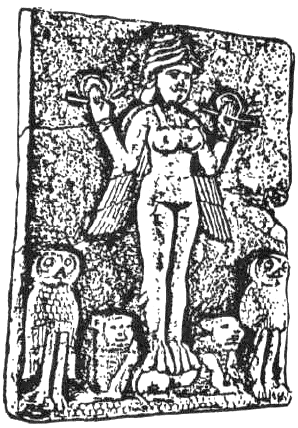
Figure 98
Although in some post-biblical
Jewish legends she was considered to have been the intended bride of
Adam (hating men because she had been rejected in favor of Eve), it
is more plausible that she was the erstwhile consort of the evil Zu
(or AN.ZU, "The celestial Zu"); in the Sumerian tale known as
Inanna
and the Huluppu Tree, the unusual tree was home to both the evil,
birdlike Anzu and to "the dark maid" Lilith. When the tree was cut
down to make furnishings for Inanna and Shamash, Anzu flew away and
Lilith "fled to wild, uninhabited places."
With the passage of time, and as the Gods themselves became more
distant and less visible, the "demons" were held
responsible for every malady, mishap, or misfortune. Incantations
were composed, prescribed appeals to the Gods to call off the
evildoers; amulets were made (to be worn or affixed to doorposts)
whose "sacred words" could defy the demon depicted on the amulet - a
practice that continued well into the latest pre-Christian times
(Fig. 99) and has persisted thereafter.
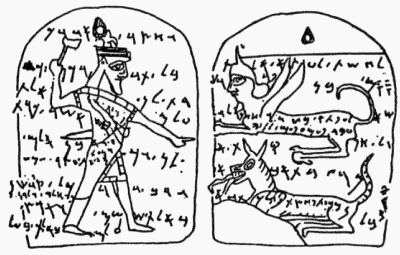
Figure 99
On the other hand, in post-biblical times and the Hellenistic Age
that followed the conquests of Alexander, Angels as we think of them
nowadays came to dominate popular and religious beliefs. In the
Hebrew Bible, only Gabriel and Michael are mentioned, in the Book of
Daniel, out of the seven archangels that were listed in
post-biblical times.
The angelic tales in the Book of Enoch and
other books of the Apocrypha were just the foundation of a whole
array of Angels inhabiting the various heavens and carrying out
divine commandments - components of a wide-ranging Angelology that
has captivated human imagination and yearnings ever since. And to
this day, who does not wish for his or her Guardian Angel?
|
The Two Faces of Pluto
The earliest mention of Usmu is in the Epic of Creation, in the
segment dealing with the rearranging of the Solar System by
Nibiru/Marduk after the celestial collision. Having cleaved Tiamat,
shunting the intact half of her to become Earth (with its companion,
the Moon) and creating out of the shattered half the Asteroid Belt
between Mars and Jupiter (and comets), the Invader now turned his
attention to the outer planets.
There, Gaga, a satellite of Anshar (Saturn), had been pulled off its
orbit to "visit" the other planets. Now Nibiru/ Marduk, beholden to
the planet that "begot" him in the first place - Nudimmud/Ea (the one
we call Neptune) - presented the roving small planet as a "gift" to
Ea’s spouse Damkina: "To Damkina, his mother, he offered him as a
joyous gift; as Usmu he brought him to her in an unknown place,
entrusting to him the chancellorship of the Deep."
The Sumerian name of this planetary God, Isimud, meant "at the tip,
at the very end." The Akkadian name Usmu meant "Two Faced." This,
indeed, is a perfect description of the odd orbit of the outermost
planet (excluding Nibiru). Not only is the orbit unusual in that it
is inclined to the common orbital plane of the planets in our Solar
System - it is also such that it takes Pluto outward, beyond Neptune,
for the better part of its 248-249 year (Earth-years, that is)
orbit-but brings it inside the orbit of Neptune for the rest of the
time (see following illustration).
Pluto, thus, shows two faces to
its "master" Enki/Neptune: one when it is beyond it. the other when
it is in front of it.
Astronomers have speculated, ever since the discovery of Pluto in
1930, that it was once a satellite - presumably of Neptune; but
according to the Epic of Creation, of Saturn. The astronomers,
however, cannot account for the odd and inclined orbit of Pluto. The
Sumerian cosmogony, revealed to them by the Anunnaki has the
answer; Nibiru did it . . .

|
Back to Contents
|
















